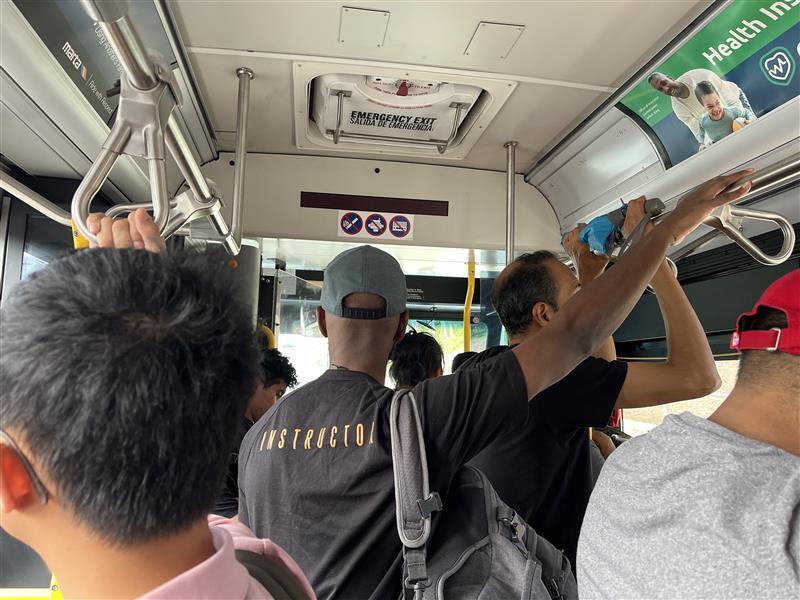
Caption
MARTA passengers fill the 39 bus as it rides up Buford Highway in northeastern metro Atlanta.
Credit: Amanda Andrews / GPB News
|Updated: June 26, 2025 10:37 AM
LISTEN: While MARTA is promising passengers improved service and technology, it's struggling to collect the funds to make those changes. GPB's Amanda Andrews reports on the state of MARTA.

MARTA passengers fill the 39 bus as it rides up Buford Highway in northeastern metro Atlanta.
Thousands of visitors will be visiting Atlanta next year while the city hosts eight World Cup games and many will expect to use public transit to explore the city. The Metro Atlanta Rapid Transit Authority, or MARTA, claims its more than ready for an influx of passengers.
Frequent riders and even Atlanta City Council members remain skeptical.
During Monday evening rush hour at the Lindbergh MARTA station, 30 people, including investigative reporter Alex Ip, waited for the next bus going up Buford Highway.
The bus was about 15 minutes late. Ip said he has seen that a lot.
Aside from being a reporter for The Xylom, Ip has a Georgia Tech degree in environmental engineering. For the past seven months, he said he’s been systematically riding MARTA transit options and looking for ways MARTA doesn’t work.
The fare boxes in the front of the bus are a common issue.
“One thing I do notice right now was the bus driver was actually covering over the fare box just to try to get as many people in as possible without them being stuck at the front door,” Ip said.
The driver was covering the fare box because this bus was already late. Every second spent waiting for people to pay the fare just makes that worse. Ip said he uses the new MARTA app to pay his fare.
“So I can just tap my phone, you know, get in the bus,” he said. “But it's harder for folks if they're just trying to count cash or trying to figure out where, you know, their Breeze Card is."
Ip said he sees drivers choosing saving time over collecting fares a lot — including here on Buford Highway, the busiest route in the whole MARTA system, during peak hours.
This is one way MARTA is losing money even from the people who do take transit. MARTA’s own regulation requires fares to be 35% of its revenue. Last year, it was 10%.
Meanwhile, all the changes MARTA said it’s making to ensure trains and buses are on time further cost money. And Ip said riders' confidence in MARTA is eroding.
“There's some serious questions to be asked about how the governance of MARTA is affecting all of this, in the grand scheme of things,” Ip said. “Especially as the World Cup's going to come around.”
That’s why MARTA officials announced several fare collection upgrades to recover the estimated $7 million lost to what the agency calls "fare evasion." MARTA Chief of Staff Steven Parker said the new technology will be up and running by the World Cup.
“We're also looking at enhancing our tap-to-pay features,” Parker said. “So, people will be able to pay with a card, or with their watches, or their phones. And then we're also getting new fare gates, which will be another feature that will be in place.”
MARTA said it’s updating the Breeze Mobile 2.0 app and that it will run extra trains before and after all eight World Cup games. But these promises for better service come amid budget cuts that are removing staff positions in program management, planning, infrastructure and research.
Recently, Atlanta City Council President Doug Shipman asked MARTA CEO Collie Greenwood how he plans to expand service without expanding staff.
“Do you have the the manpower and the womanpower to deliver those projects?" Shipman said. “How can you be confident that you do?”
The upcoming fiscal year
organization chart
shows there are still 16 vacant positions. Greenwood said MARTA has the workforce and many of the cut positions had been vacant for years. No one had been doing that work, anyway.
“Should we get to a point where it's a bandwidth issue, we can address that through contractual services,” Greenwood said.
Right now, as Atlanta is hosting the Club World Cup, MARTA is testing systems it plans to use for the larger 2026 tournament, including transit ambassadors, a pre-game shuttle train, and additional teams and police on platforms.